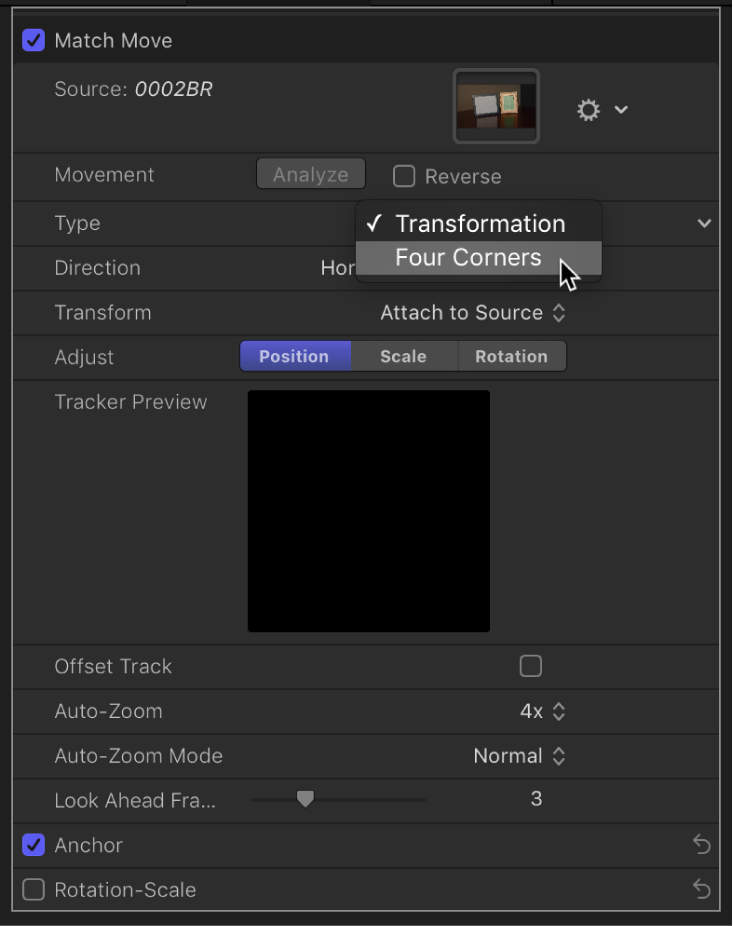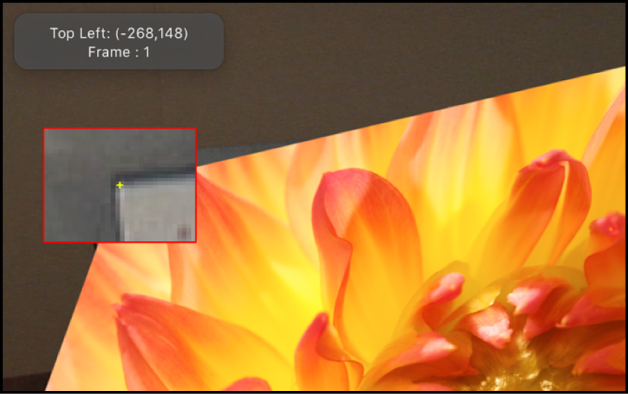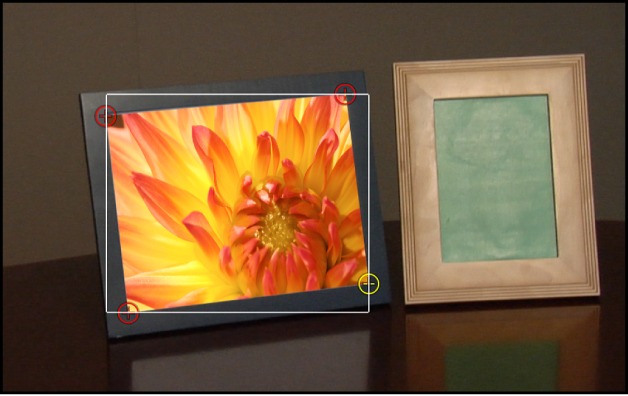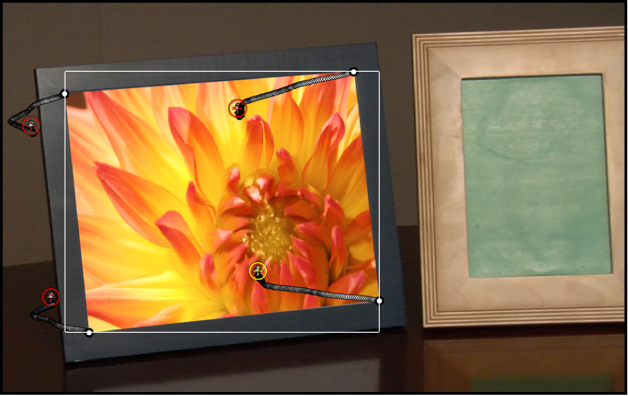Motion User Guide
- Welcome
-
- Intro to basic compositing
-
- Intro to transforming layers
-
- Intro to transforming layers in the canvas
- Transform layer properties in the canvas
- Transform tools
- Change layer position, scale, or rotation
- Move a layer’s anchor point
- Add a drop shadow to a layer
- Distort or shear a layer
- Crop a layer
- Modify shape or mask points
- Transform text glyphs and other object attributes
- Align layers in the canvas
- Transform layers in the HUD
- Transform 2D layers in 3D space
-
- Intro to behaviors
- Behaviors versus keyframes
-
- Intro to behavior types
-
- Intro to Parameter behaviors
- Audio behavior
- Average behavior
- Clamp behavior
- Custom behavior
- Add a Custom behavior
- Exponential behavior
- Link behavior
- Logarithmic behavior
- MIDI behavior
- Add a MIDI behavior
- Negate behavior
- Oscillate behavior
- Create a decaying oscillation
- Overshoot behavior
- Quantize behavior
- Ramp behavior
- Randomize behavior
- Rate behavior
- Reverse behavior
- Stop behavior
- Track behavior
- Wriggle behavior
-
- Intro to Simulation behaviors
- Align to Motion behavior
- Attracted To behavior
- Attractor behavior
- Drag behavior
- Drift Attracted To behavior
- Drift Attractor behavior
- Edge Collision behavior
- Gravity behavior
- Orbit Around behavior
- Random Motion behavior
- Repel behavior
- Repel From behavior
- Rotational Drag behavior
- Spring behavior
- Vortex behavior
- Wind behavior
- Additional behaviors
-
- Intro to using generators
- Add a generator
-
- Intro to image generators
- Caustics generator
- Cellular generator
- Checkerboard generator
- Clouds generator
- Color Solid generator
- Concentric Polka Dots generator
- Concentric Shapes generator
- Gradient generator
- Grid generator
- Japanese Pattern generator
- Lens Flare generator
- Manga Lines generator
- Membrane generator
- Noise generator
- One Color Ray generator
- Op Art 1 generator
- Op Art 2 generator
- Op Art 3 generator
- Overlapping Circles generator
- Radial Bars generator
- Soft Gradient generator
- Spirals generator
- Spiral Drawing generator
- Use Spiral Drawing onscreen controls
- Star generator
- Stripes generator
- Sunburst generator
- Truchet Tiles generator
- Two Color Ray generator
- Save a modified generator
-
- Intro to filters
- Browse and preview filters
- Apply or remove filters
-
- Intro to filter types
-
- Intro to Color filters
- Brightness filter
- Channel Mixer filter
- Color Balance filter
- Example: Color-balance two layers
- Color Curves filter
- Use the Color Curves filter
- Color Reduce filter
- Color Wheels filter
- Use the Color Wheels filter
- Colorize filter
- Contrast filter
- Custom LUT filter
- Use the Custom LUT filter
- Gamma filter
- Gradient Colorize filter
- HDR Tools filter
- Hue/Saturation filter
- Hue/Saturation Curves filter
- Use the Hue/Saturation Curves filter
- Levels filter
- Negative filter
- OpenEXR Tone Map filter
- Sepia filter
- Threshold filter
- Tint filter
-
- Intro to Distortion filters
- Black Hole filter
- Bulge filter
- Bump Map filter
- Disc Warp filter
- Droplet filter
- Earthquake filter
- Fisheye filter
- Flop filter
- Fun House filter
- Glass Block filter
- Glass Distortion
- Insect Eye filter
- Mirror filter
- Page Curl filter
- Poke filter
- Polar filter
- Refraction filter
- Ring Lens filter
- Ripple filter
- Scrape filter
- Sphere filter
- Starburst filter
- Stripes filter
- Target filter
- Tiny Planet filter
- Twirl filter
- Underwater filter
- Wave filter
-
- Intro to Stylize filters
- Add Noise filter
- Bad Film filter
- Bad TV filter
- Circle Screen filter
- Circles filter
- Color Emboss filter
- Comic filter
- Crystallize filter
- Edges filter
- Extrude filter
- Fill filter
- Halftone filter
- Hatched Screen filter
- Highpass filter
- Indent filter
- Line Art filter
- Line Screen filter
- MinMax filter
- Noise Dissolve filter
- Pixellate filter
- Posterize filter
- Relief filter
- Slit Scan filter
- Slit Tunnel filter
- Texture Screen filter
- Vignette filter
- Wavy Screen filter
- Publish filter parameters to Final Cut Pro
- Using filters on alpha channels
- Filter performance
- Save custom filters
-
- Intro to 3D objects
- Add a 3D object
- Move and rotate a 3D object
- Reposition a 3D object’s anchor point
- Exchange a 3D object file
- 3D object intersection and layer order
- Using cameras and lights with 3D objects
- Save custom 3D objects
- Guidelines for working with 3D objects
- Working with imported 3D objects
-
- Intro to 360-degree video
- 360-degree projects
- Create 360-degree projects
- Add 360-degree video to a project
- Create a tiny planet effect
- Reorient 360-degree media
- Creating 360-degree templates for Final Cut Pro
- 360-degree-aware filters and generators
- Export and share 360-degree projects
- Guidelines for better 360-degree projects
-
- Intro to tracking
- How does motion tracking work?
- Motion tracking behavior types
- Analyze motion in a clip
- Stabilize a shaky clip
- Unstabilize a clip
- Use a range of frames for analysis
- Load existing tracking data
- Track shapes, masks, and paint strokes
- Track a filter’s position parameter
- Adjust onscreen trackers
- Save tracks to the Library
-
- Intro to preferences and shortcuts
-
- Intro to Keyboard shortcuts
- Use function keys
- General keyboard shortcuts
- Audio list keyboard shortcuts
-
- Tools keyboard shortcuts
- Transform tool keyboard shortcuts
- Select/Transform tool keyboard shortcuts
- Crop tool keyboard shortcuts
- Edit Points tool keyboard shortcuts
- Edit shape tools keyboard shortcuts
- Pan and Zoom tools keyboard shortcuts
- Shape tools keyboard shortcuts
- Bezier tool keyboard shortcuts
- B-Spline tool keyboard shortcuts
- Paint Stroke tool keyboard shortcuts
- Text tool keyboard shortcuts
- Shape mask tools keyboard shortcuts
- Bezier Mask tool keyboard shortcuts
- B-Spline Mask tool keyboard shortcuts
- Transport control keyboard shortcuts
- View option keyboard shortcuts
- HUD keyboard shortcuts
- Inspector keyboard shortcuts
- Keyframe Editor keyboard shortcuts
- Layers keyboard shortcuts
- Library keyboard shortcuts
- Media list keyboard shortcuts
- Timeline keyboard shortcuts
- Keyframing keyboard shortcuts
- Shape and Mask keyboard shortcuts
- 3D keyboard shortcuts
- Miscellaneous keyboard shortcuts
- Touch Bar shortcuts
- Move assets to another computer
- Work with GPUs
- Glossary
- Copyright

Corner-pin a foreground object in Motion
For more control over tracking in a Match Move behavior, use the four-corner option, which lets you track four points on a source clip and then apply the recorded motion to the four corners of a destination object. This process is known as corner pinning.
Tip: If the position, size, or angle of the destination object is radically different from that of the source pattern (an angled TV screen or picture frame, for example) you may need to adjust the foreground object before you apply the Match Move behavior. You can reorient the foreground object in the canvas using the Distort tool (available in the transform tools pop-up menu in the canvas toolbar).
Use four-corner tracking to pin a foreground object to a background element
This workflow is ideal for a four-corner pin in which the transformed or pinned image is the same size as the background reference pattern it’s being tracked to. In the following example, a foreground image is pinned to a background clip of a picture frame.
In Motion, drag the playhead to the frame where you want to start the track analysis, then apply a Match Move behavior to the foreground object.
Note: If you apply the Match Move behavior to a 2D group (rather than an individual layer in a group), make sure the Fixed Resolution checkbox is selected in the Group Inspector. When you apply the Match Move behavior to a 3D group, the Four Corners option is not available. To corner-pin a 3D group, select the Flatten checkbox in the Group Inspector.
In the Behaviors Inspector, click the Type pop-up menu, then choose Four Corners.

In the canvas, a tracker appear at each corner of the foreground object’s bounding box. In the Inspector, the Anchor and Rotation-Scale checkboxes are replaced with the Top Left, Top Right, Bottom Right, and Bottom Left checkboxes; each checkbox activates or deactivates a tracker in the canvas.
In the canvas, drag each tracker to a corner of the background element (in this example, the corners of the picture frame).
As you drag a tracker, a magnified inset appears to help you position each tracker.


Note: You can specify a portion of a clip to be analyzed. See Use a range of frames for analysis in Motion.
Click the Analyze button in the Behaviors Inspector or HUD.
The foreground element is pinned to the background element; four motion paths show the transformation occurring at each corner.

If necessary, make minor adjustments to the foreground element (such as modifying scale or rotation) by doing the following:
Click the Transform pop-up menu in the Behaviors Inspector, then choose Mimic Source.
The default option in the Transform pop-up menu (Attach to Source) does not permit transformations of the foreground element.
Open the Properties Inspector and make any necessary adjustments to the foreground object using the Scale slider, Rotation dial, or other controls.
For more information on the Mimic Source and Attach to Source transform options, see Match Move controls in Motion.
If corner pinning does not produce a successful track
If the Match Move corner pinning method described above fails to yield a successful track, try four-point tracking using the Analyze Motion behavior. In this workflow, the four-point tracking data collected from the Analyze Motion behavior is loaded into a Match Move behavior to corner-pin a foreground object.
In Motion, go to the frame where you want to start the track and apply an Analyze Motion behavior to the background element.
Important: Whereas the Match Move behavior is always applied to the foreground (destination) layer, the Analyze Motion behavior is always applied to the background (source) layer.
By default, a single tracker appears in the canvas.
Drag the tracker (Track 1) to a reference pattern in the top-left corner of the background element.
Note: For four-point analysis, the trackers should be positioned in a clockwise order, starting in the upper-left corner. This ensures the proper alignment of your element when the transformation is applied.

In the Behaviors Inspector, click Add to add a second tracker, then drag the second tracker (Track 2) to a reference pattern in the top-right corner of the background element.
Add another tracker (Track 3), then drag it to a reference pattern in the bottom-right corner of the background element.
Add another tracker (Track 4), then drag it to the reference pattern in the bottom-left corner of the background element.
Note: To modify parameters for any of the trackers, position the pointer over the right side of the track parameter row and click Show.
Click the Analyze button in the Behaviors Inspector or HUD.
The track is generated and its data is saved in the behavior.
Apply a Match Move behavior to the foreground element you want to corner-pin.
In the Match Move area of the Behaviors Inspector, click the Action pop-up menu (with the gear icon), then choose the Analyze Motion track.
Doing so applies the Analyze Motion tracking data recorded in step 6 to the Match Move behavior.
In the Match Move area of the Behaviors Inspector, click the Type pop-up menu, then choose Four Corners.
The four-point tracking data from the Analyze Motion behavior is applied to the foreground object.
Note: In a Match Move behavior with four-point tracking, trackers are placed in the correct order (clockwise from the top left) in the canvas after you choose Four Corner from the Type pop-up menu in the Behaviors Inspector.
Remove parallax from a 3D group
When you match move 3D groups that contain objects offset in Z space (depth), parallax is simulated. Parallax is the apparent shift of an object against a distant background caused by a change in perspective, such as a change in camera position. You can disable this effect, if necessary, by doing the following:
In Motion, select the Flatten checkbox for the tracked group in the Group Inspector.
The parallax effect is removed.